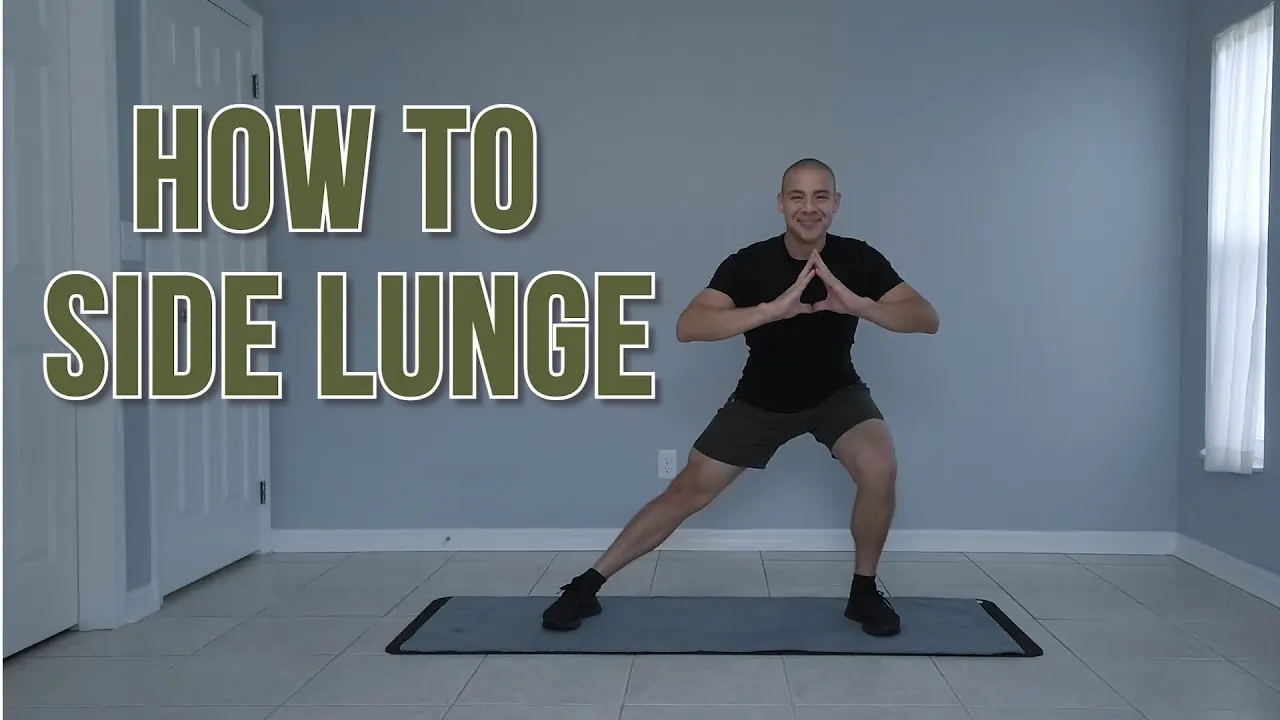Side Lunge Exercise
Table of Contents
What is the Side Lunge exercise?
The Side Lunge is a lower-body exercise that targets the quads, glutes, and inner thighs while improving lateral stability and mobility. It involves stepping sideways into a deep lunge, keeping one leg straight and the other bent, engaging the core for balance.
You might wish to include side lunges if you have any leg imbalances. Side lunges target the legs separately, whereas workouts like squats involve both legs simultaneously. This helps you develop balance on both legs, strengthen your stabilizing muscles, and enhance your balance.
There are many different types of lunges, which are an easy bodyweight exercise you can perform at home to strengthen your legs. Side lunges are among the most popular varieties because they let you work from a different angle than traditional lunges.
Essentially, a side lunge allows you to strengthen more parts of your lower body during your exercises. However, according to coaches, you may modify this exercise to make your workout even more dynamic and focus on different body parts.
However, if you’re not using the proper form, you could end up hurting yourself or not getting the full advantage of this action. Here are all the details you need to know about side lunges, as well as a few new variations to try during your next workout.
Which muscles are used in Side Lunges?
- Glutes
- Hamstrings
- Quads
- Adductor Muscles
Who can benefit from side lunges?
Most people find that side lunges are a good exercise. is an excellent way to stretch your inner thighs, warm up your hips before training, and increase your hip mobility in general. You spend a lot of time pushing forward when you walk, run, cycle, and go about your day in general, so the various angles you get with side lunges are crucial.
The result of too many repetitive actions is injury. While you run and walk in a straight line, side lunges force you to stretch and move in a different plane. The abductors, glutes, hamstrings, and quadriceps can all be strengthened by including this exercise in your training program.
Should side lunges be performed with weights?
The addition of weight makes the activity harder and contributes to progressive overload. Progressive overload aims to strengthen your bones and muscles by progressively increasing the force on them.
Makes your muscles stronger by increasing their tension. The only warning is that you shouldn’t necessarily try to go as heavy as you can because that’s where people make mistakes. Dumbbells and other weights should be used more as a support system or accessory than as a way to work out your muscles to the limit.
How should one perform a side lunge?
- To begin, place your feet hip-width apart on the floor.
- With your left leg out to the side, take a wide step. Make sure the toes on both feet point in the same direction.
- As you step out, keep your hips back and bend your left knee. You should feel as though you are attempting to sit in a chair using only one side of your lower body.
- To get back to where you were before, push off with your left foot.
- Use your left leg for one set of side lunges, then move on to your right leg.
How to Do Side Lunges
Side lunges are a logical next step if you know how to perform lunges. There should be plenty of room for you on either side. No specialized equipment is needed for beginners. As your strength increases, you can try doing this exercise with weights or even on a vibration plate for a few repetitions.
- Start by placing your feet hip-width apart while standing.
- Using your left leg, take a broad step sideways. Your feet should be flat on the ground with both of your toes pointed in the same direction.
- As you step out, keep your hips back and bend your left knee. You should feel as though you are attempting to sit in a chair using only one side of your lower body.
- To get back to the starting position, push off your left foot to release the position.
- Use your left leg for one set of side lunges, then move on to your right leg.
- Continue for more sets.
Side Lunge Exercise Video
Benefits of the Side Lunge
Side lunges are a lower-body exercise, just like standard lunges. Large leg muscular groups like the hamstrings and quadriceps are their main aim. The adductors and outer glutes, two muscles in the inner thighs, are also worked by lateral lunges. Although side lunges are more challenging than squats because they require a lot of balance, they may also be easier on the lower back.
Regularly performing side lunges helps enhance stability and balance, particularly in the ankles and knees, which is advantageous for daily tasks. It’s easier to get up from a sitting position, avoid falls, and exercise with better form when you have a strong balance.
For those who enjoy winter sports, side lunges might be particularly beneficial for increasing leg strength. The adductors and other inner thigh muscles are used when practicing. Side lunges are an excellent way to get ready for an outdoor adventure or competition because they strengthen both the inner and outer thighs.
Other Variations of the Side Lunge
To fit your goals and ability level, you can do this exercise in a variety of ways.
Chair Balance Side Lunge
During this exercise, having a solid chair or other object in front of you may aid with balance. However, if you are holding onto something in front of you, take care not to lean forward too much. When lunging to the left, hold on with your right hand; when lunging to the right, hold on with your left.
Weighted Side Lunge
Start with bodyweight only and work your way up to gripping weights in each hand for more intense side lunges. Keep your arms by your sides rather than placing your hands in front of your chest. Your leading leg’s knee should be between your weight-bearing arms as you make a sideways lunge.
This exercise becomes more complex when weight is added, and it also helps create progressive overload. You can keep increasing the dumbbells’ weight as you get better. This helps you develop muscle over time and strengthen your lower body. As an extra challenge, you can also utilize a kettlebell.
- Make the transition from static weight holding to an upright row. This strengthens your shoulders and offers a challenge to your core.
- Start by holding a kettlebell in front of you with both hands while standing with your feet hip-width apart.
- Use your left leg to take a wide step to the side. As you take a step outside, bend your left knee.
- Swing the kettlebell straight up in the side-step position while keeping your arms parallel to the floor by stretching your elbows outward and upward. Put the kettlebell back to its starting position.
- Continued, the starting position requires pushing off your left foot.
Cossack Squat
The Cossack squat is comparable to a side lunge, but it requires you to turn your foot out at the bottom and move considerably further into the range of motion. This bodyweight exercise is more complex.
- Step your left foot out to the side to start, exactly as you would with a side lunge.
- After you are in the side-step posture, turn your right foot out, pointing your toes toward the ceiling, and keep lowering your glutes into your left heel.
- Return to the starting position by reversing.
Common Mistakes
Even though side lunges are easy for beginners, it’s important to use good technique to reduce your risk of injury. You can improve your form by avoiding these common mistakes.
Lunging Too Shallow or Too Deep
When lunging, a side step that is too small does not improve balance or strength. However, an overly big side lunge might put stress on the groin and inner thighs. While determining the appropriate step size for a side lunge is not an exact technique, it is an essential skill of fitness. To keep your alignment on the right path, it can be useful to use a mirror.
Your other knee should be straight out and only a few inches off the ground, while your leading leg—the leg you step out with—should be bent at a 90-degree angle.
Leaning Forward
It may feel natural to lean your upper body forward at the deepest point of the side lunge because your hips are back and your leading leg knee is forward. But doing so will throw you off balance, which may result in bad posture and slouching. You want to keep your back as straight as possible because bending it might cause strain, even though the side lunge isn’t specifically meant for the back.
Knee Extending Towards Toes
Similar to squats and standard lunges, side lunges require that your bent knee—the side you are lunging on—not extend earlier your toes. This may put a lot of strain on your knee joint and move more of the weight onto your quadriceps.
Safety and Precautions
- Exercise of any kind, including bodyweight and weighted side lunges, should be done carefully to avoid strain or injury.
- Those who already have knee issues should use more caution. When performing side lunges, stop the activity right away and consult a healthcare provider if you feel any knee pain or discomfort.
- Depending on fitness level, side lunges may need to be modified during the first and second trimesters of pregnancy, but they are generally safe.
Conclusion
The side lunge is a powerful lower-body workout that increases flexibility and balance while strengthening the inner thighs, legs, and glutes. You can improve the general strength and suppleness of your lower body by including side lunges in your exercise regimen.
This exercise is an excellent addition to any fitness program, whether it is utilized for strength training, improving athletic performance, or preventing injuries. Maintain good technique, use your core, and progressively up the intensity as your strength increases to get the most out of your workouts.
FAQs
Which muscles are used in side lunges?
The quadriceps, glutes, hamstrings, and inner thighs (adductors) are the main muscles worked during side lunges, but the core is also used for stabilization.
How do I perform a side lunge?
Your feet should be hip-width apart.
Take a big step to the side and bend the knee of the front leg while keeping the other leg straight. Keep your back straight and your chest up as you lower your hips.
To go back to the starting position, push off with the leg bent.
What advantages do side lunges provide?
Increases the strength of the muscles in the lower body.
Increases hip flexibility and mobility
Improves stability and balance
Keeps injuries at bay by enhancing lateral movement
Can I perform side lunges daily?
Yes, but it’s crucial for recovery. If using them daily, alternate with other leg workouts or maintain a moderate level of intensity.
Which side lunge problems are most common?
The knee can be extended beyond the toes. Leaning forward excessively or rounding the back
Stepping too narrowly to allow for a complete range of motion
How can I increase the difficulty of side lunges?
Add a kettlebell or dumbbell.
Jump laterally in between lunges.
Reduce the speed of the motion to enhance muscle activation.
Are side lunges beneficial for losing weight?
Yes, side lunges aid in total fat loss and muscle toning when paired with a calorie-restricted diet and aerobic exercises.
Can side lunges be performed by those who have knee pain?
Before trying side lunges, get advice from a physician or trainer if you have knee problems. Adjust by lowering the depth or experimenting with supported versions.
References
- Cpt, P. W. (2024, May 19). Learn to master mountain climbers. Verywell Fit. https://www.verywellfit.com/mountain-climbers-exercise-3966947
- Ba, G. R. (2022, March 10). What muscles do mountain climbers work? Healthline. https://www.healthline.com/health/fitness/what-do-mountain-climbers-work
- Wikipedia contributors. (2025b, March 15). Mountaineering. Wikipedia. https://en.wikipedia.org/wiki/Mountaineering
- Butt & hip Exercises | Mountain Climbers. (n.d.). https://www.acefitness.org/resources/everyone/exercise-library/258/mountain-climbers/?srsltid=AfmBOoq2pDRRe7R1JZhMfn11mGp3y3e-mEchZJtwug-cS4g_tWwlJ7nW
- Sparacino, A. (1970, January 1). How to Master Mountain Climbers—Plus 3 challenging variations. https://www.onepeloton.com/blog/mountain-climbers
- ‘I did 50 mountain climbers every day for 2 weeks, here’s what happened.’ (2024, February 6). Women’s Health. https://www.womenshealthmag.com/uk/fitness/a46644892/mountain-climbers/







